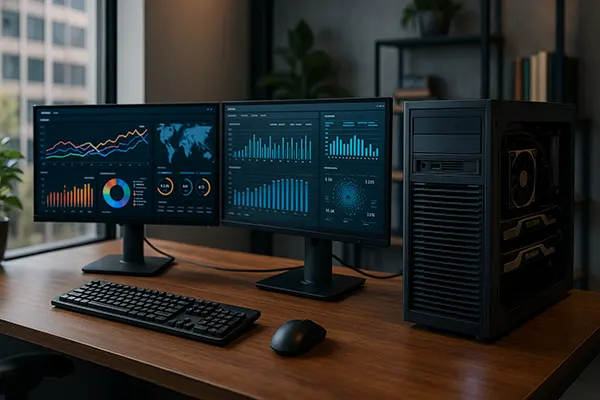
Choosing a Professional Workstation for Big Data Tasks: Key Considerations
Working with big data requires far more than a typical office computer. Professionals in analytics, modelling, and machine learning need systems designed to handle enormous workloads with precision and stability. A well-chosen workstation ensures smooth processing, reduces downtime, and improves overall productivity. Knowing what to look for is crucial before investing in such hardware.
Key Differences Between PCs and Workstations
Standard personal computers are built for everyday tasks like web browsing, document editing, and light multimedia use. They rely on consumer-grade components that are affordable but not engineered for the stress of intensive data workloads. As a result, they often struggle with performance bottlenecks when dealing with large datasets.
Workstations, on the other hand, are designed specifically for professional environments. They feature high-core-count processors, error-correcting RAM (ECC), and professional-grade graphics cards that are validated for stability and precision. These systems are capable of sustained operation under heavy load without compromising reliability.
Another difference is scalability. Workstations are built to be expanded with additional memory, faster storage, and more powerful GPUs as demands increase. This makes them a long-term investment for data analysts and engineers who expect their computational needs to grow over time.
How These Differences Affect Workflow
Using a standard PC for data-intensive tasks often leads to slow processing, frequent crashes, and limited multitasking ability. These limitations can severely impact productivity and delay critical project timelines.
A professional workstation dramatically reduces processing time, allowing for real-time data modelling, faster analytics, and more accurate simulations. This means professionals can work on larger and more complex datasets without system slowdowns.
Moreover, the reliability of workstation components minimises the risk of data corruption or unexpected downtime, which is essential when handling sensitive or high-value datasets that require consistent accuracy.
Hardware Requirements for Big Data Work
The central processing unit (CPU) is the heart of a workstation. For big data tasks, a multi-core processor with high clock speeds is essential. Modern workstation CPUs often offer 16–64 cores, which allows parallel processing of large datasets without performance drops.
Memory (RAM) is another crucial factor. While 32 GB is the minimum for entry-level big data work, most professionals require 128 GB or more, preferably with ECC support to ensure data integrity during complex computations.
Storage also plays a major role. Solid-state drives (SSDs) with NVMe interface offer the speed necessary for reading and writing massive data files. For redundancy and backup, many workstations include multiple drives in RAID configurations.
Importance of Graphics and Parallel Processing
High-performance graphics processing units (GPUs) are indispensable for data modelling, machine learning, and visualisation. Modern GPUs can accelerate workloads by performing thousands of parallel computations at once, which significantly cuts processing time.
For most big data applications, at least one professional-grade GPU with 24 GB or more of video memory is recommended. In scenarios like deep learning, using multiple GPUs connected via NVLink or similar technology can further enhance throughput.
Dedicated GPU acceleration not only boosts performance but also frees up CPU resources, enabling smoother multitasking and faster execution of concurrent workloads.

Cooling, Energy Efficiency, and Reliability
Workstations generate considerable heat during sustained high-load operations, making efficient cooling systems essential. High-quality air or liquid cooling solutions prevent thermal throttling, ensuring components operate at maximum performance levels.
Energy consumption is another factor to consider. Professional workstations are equipped with high-wattage power supplies and energy-efficient components that balance performance with power draw, reducing operational costs over time.
Reliability is paramount. Enterprise-grade motherboards, redundant power supplies, and chassis designed for 24/7 operation ensure the system can run continuously without failures, which is vital for long-running analytical tasks.
Example Configurations for Different Budgets
Entry-level configurations may include a 16-core CPU, 64 GB of ECC RAM, a 1 TB NVMe SSD, and a single mid-range professional GPU. This setup is suitable for basic data analysis and modelling tasks.
Mid-range setups often feature 32-core CPUs, 128 GB of RAM, multiple NVMe SSDs in RAID, and a high-end professional GPU with 24 GB of VRAM, offering strong performance for machine learning and advanced analytics.
High-end workstations can include dual 48-core CPUs, 256–512 GB of RAM, several NVMe SSDs for storage pools, and multiple top-tier GPUs. These are ideal for large-scale simulations, deep learning, and complex data engineering pipelines.
